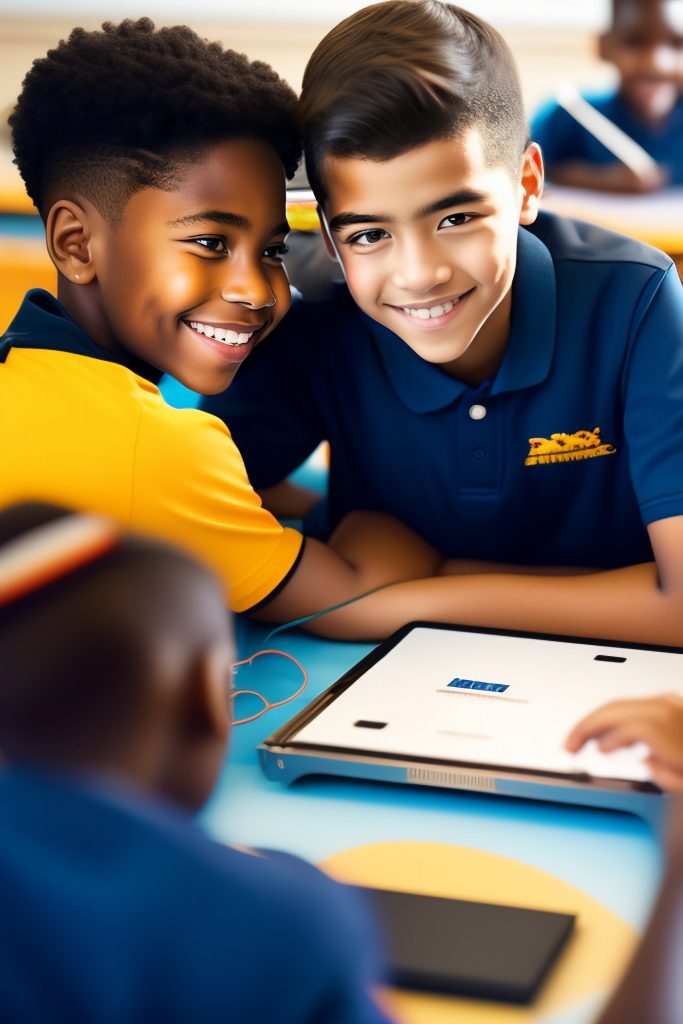
“Today a Reader, Tomorrow a Leader”
Developing leadership skills in children is important as it helps them to become successful adults who are capable of leading others, making decisions, and achieving their goals. There are many ways to develop leadership skills in children, including encouraging communication, setting goals, providing opportunities for teamwork, giving them responsibilities, teaching problem-solving skills, encouraging creativity, building confidence, teaching empathy, providing leadership opportunities, teaching self-reflection, encouraging curiosity, teaching time management, providing positive role models, teaching adaptability, and encouraging self-motivation.
By encouraging children to develop these skills, they become more self-aware, self-driven, and better able to work with others. Effective leaders need to communicate well, solve problems, be creative, set goals, manage their time, and understand and respect others’ feelings and perspectives. They also need to be adaptable, resilient, and driven. By teaching children these skills from a young age, they can start to develop these traits and become the leaders of tomorrow. Developing leadership skills in children is an investment in their future and helps to prepare them for success in all areas of life.
- Encourage communication: Children should be encouraged to communicate their thoughts, feelings, and ideas with others. This helps them develop strong interpersonal skills that are necessary for effective leadership.
Encouraging communication is a crucial component of developing leadership skills in children. Effective communication skills are essential for effective leadership as leaders need to be able to articulate their ideas, listen to others, and build strong relationships. Children should be encouraged to express their thoughts, feelings, and ideas in a clear and concise manner, and to actively listen to others.
Encouraging communication also helps children to develop strong interpersonal skills, such as empathy, which are essential for effective leadership. By teaching children how to communicate effectively, they can learn how to express their opinions, negotiate, and work collaboratively with others.
This can help them to develop into confident and effective leaders who can inspire and motivate others. Encouraging communication can be done in a variety of ways, such as by providing opportunities for children to engage in conversation, asking open-ended questions, and teaching active listening skills.
By making communication a priority, children can develop the skills they need to become effective leaders who can communicate their vision and ideas clearly and persuasively.
Here’s an example:
A group of elementary school students were tasked with organizing a school fundraising event. The students were divided into different groups and given specific tasks to complete. One group was responsible for marketing the event, another group was in charge of coordinating the vendors, and a third group was responsible for planning the entertainment.
To ensure the success of the event, the teacher encouraged the students to communicate with each other regularly. The students were asked to hold regular meetings, provide updates on their progress, and share their ideas with the other groups.
During these meetings, the students were encouraged to express their thoughts and ideas openly. They were also taught to listen to others and to provide constructive feedback. As a result, the students were able to collaborate effectively, solve problems, and make decisions collectively.
Through this process, the students developed their communication skills, learned how to work as a team, and gained confidence in their abilities. The event was a huge success, and the students felt a sense of pride and accomplishment in their work.
By encouraging communication and providing opportunities for collaboration, the teacher helped the students develop leadership skills that will serve them well throughout their lives.
2. Set goals: Teach children to set achievable goals and work towards them. This helps them to develop a sense of responsibility and commitment.
Setting goals is an important part of developing leadership skills in children. Goals provide direction and purpose, and help children to focus their efforts on achieving specific outcomes. By setting goals, children can learn how to plan, prioritize, and work towards a specific objective. This skill is essential for effective leadership, as leaders need to be able to set goals and lead others towards achieving them.
When setting goals for children, it’s important to make them challenging but achievable. Goals that are too easy won’t provide a sense of accomplishment, while goals that are too difficult can be discouraging. Children should also be encouraged to break down their goals into smaller, manageable tasks. This can help them to stay motivated and track their progress.
In addition to setting goals, it’s important to provide children with the tools and resources they need to achieve them. This can include providing guidance, support, and feedback. It’s also important to celebrate children’s successes along the way, as this can help to build their confidence and motivate them to continue working towards their goals.
By teaching children how to set goals and work towards achieving them, they can develop the skills they need to become effective leaders. They can learn how to plan, prioritize, and work towards a specific objective, and they can gain the confidence they need to inspire and motivate others. Setting goals is a powerful tool for developing leadership skills in children, and can help them to achieve success in all areas of their lives.
Here’s an example:
A group of high school students were interested in organizing a community service project to help the local homeless population. To do this, they set a goal of raising $5,000 to purchase food, clothing, and other necessary items for the homeless individuals in their community.
To achieve this goal, the students broke it down into smaller, manageable tasks. They formed committees to handle different aspects of the project, such as fundraising, outreach, and logistics. They set weekly targets for fundraising, created a social media campaign to raise awareness of their project, and held a series of events to promote their cause.
Throughout the project, the students received guidance and support from their teacher and other adult mentors. They were also encouraged to reflect on their progress and adjust their approach as needed.
As a result of their hard work and dedication, the students exceeded their fundraising goal and were able to provide significant support to the homeless individuals in their community. They learned valuable leadership skills, such as goal setting, planning, and collaboration, that they can carry with them throughout their lives.
By setting and achieving their goal, the students developed a sense of purpose and accomplishment. They also learned the importance of helping others and the impact that even small actions can have on the community. These leadership skills will serve them well as they move forward and continue to make a positive impact in the world.
3. Provide opportunities for teamwork: Encourage children to work in groups and teams. This helps them to develop collaboration and cooperation skills that are essential for effective leadership.
Providing opportunities for teamwork is a great way to help children develop leadership skills. When children work in teams, they have the chance to practice communication, collaboration, and problem-solving skills. These skills are essential for effective leadership. By working with others, children can learn to share ideas, listen to others’ perspectives, and come to a consensus on the best course of action.
Teamwork also allows children to take on different roles within the group, such as being a leader, a facilitator, or a contributor. By taking on different roles, children can learn to identify their strengths and weaknesses and develop a sense of self-awareness. They can also practice delegating tasks, giving feedback, and encouraging others to participate.
Moreover, teamwork can provide a safe and supportive environment for children to practice their leadership skills. They can experiment with different approaches to leading and learn from their mistakes. They can also receive feedback and support from their peers and mentors. These experiences can help children build confidence in their abilities and develop a growth mindset.
In conclusion, providing opportunities for teamwork is an effective way to help children develop leadership skills. It allows them to practice communication, collaboration, and problem-solving skills, take on different roles, and receive feedback and support. These experiences can help children build the essential skills and confidence they need to become effective leaders in the future.
Here’s an example:
Imagine a school project where a group of students are tasked with organizing a fundraising event for a charity. To successfully complete the project, the group needs to work together, delegate tasks, and communicate effectively.
One student in the group, let’s call her Emily, takes on the role of a leader. She facilitates the group’s meetings, sets goals and deadlines, and assigns tasks to each member based on their strengths and interests. She also encourages everyone to share their ideas and feedback, ensuring that everyone feels valued and heard.
As the project progresses, Emily faces some challenges, such as dealing with conflicting ideas, motivating some members who are less engaged, and managing the group’s timeline. However, she approaches these challenges as learning opportunities, seeking feedback from her peers and reflecting on her own leadership style.
Through this project, Emily develops her leadership skills by practicing communication, collaboration, and problem-solving. She learns to listen actively, provide constructive feedback, and motivate others. She also gains self-awareness by identifying her strengths and weaknesses as a leader.
In the end, the group successfully raises funds for the charity, and Emily emerges as a confident and effective leader. She carries these skills and experiences with her, building a foundation for future leadership opportunities.
4. Give them responsibilities: Assigning age-appropriate responsibilities such as taking care of pets, helping with household chores, or organizing events helps children develop a sense of ownership and accountability.
Giving children responsibilities is a great way to help them develop leadership skills. When children are given tasks that require decision-making, problem-solving, and accountability, they learn to take ownership of their actions and develop a sense of responsibility. This, in turn, can help them build essential leadership skills that will benefit them in the future.
Moreover, giving children responsibilities can help them develop a sense of purpose and self-confidence. By completing tasks and achieving goals, children feel a sense of accomplishment and pride. This, in turn, can motivate them to take on more challenges and develop their leadership skills further.
In conclusion, giving children responsibilities is an effective way to help them develop leadership skills. It allows them to practice decision-making, problem-solving, accountability, and independence. It also helps them develop a sense of purpose and self-confidence, which can motivate them to take on more challenges and develop their leadership skills further.
Here’s an example:
Imagine a family where the parents give their children the responsibility of planning and preparing one meal per week. Each child takes turns choosing the menu, creating a shopping list, and cooking the meal with the help of their parents.
One child, let’s call him David, takes on the responsibility of planning and preparing a family dinner. He starts by researching different recipes, considering everyone’s dietary restrictions and preferences. He then creates a shopping list, budgeting the expenses carefully. Finally, he cooks the meal, following the recipe and making adjustments as needed.
Through this experience, David develops his leadership skills by practicing decision-making, problem-solving, and accountability. He learns to prioritize tasks, manage his time, and work independently. He also communicates with his family members, getting their feedback and making adjustments to the plan.
In the end, David successfully prepares a delicious meal for his family, and they all enjoy it together. He emerges as a confident and responsible leader, carrying these skills and experiences with him, building a foundation for future leadership opportunities.
This example shows how giving children responsibilities can help them develop essential leadership skills. It allows them to practice decision-making, problem-solving, accountability, and independence, and develop a sense of purpose and self-confidence.
5. Teach problem-solving skills: Children should be taught problem-solving skills, such as brainstorming, critical thinking, and decision-making, that are essential for leadership.
Teaching problem-solving skills to children is a crucial step in helping them develop leadership skills. When children learn how to identify, analyze, and solve problems, they become more confident and effective leaders. Problem-solving skills also help children develop critical thinking and decision-making abilities that will benefit them in all aspects of their lives.
One way to teach problem-solving skills to children is to encourage them to think creatively and critically about real-world problems. Parents and teachers can ask children to identify a problem they have noticed, such as litter in the park, and then brainstorm possible solutions. This process teaches children to look at problems from different angles and to consider multiple perspectives.
Another way to teach problem-solving skills is to use games and activities that require problem-solving. For example, puzzles, scavenger hunts, coding and board games all provide opportunities for children to practice critical thinking and decision-making skills.
Teaching problem-solving skills also involves teaching children to accept failure as part of the learning process. Children need to understand that not every solution they come up with will work, but that this is an opportunity to learn and improve. By encouraging children to reflect on their failures and successes, they learn to develop resilience and perseverance, which are essential qualities of effective leaders.
In conclusion, teaching problem-solving skills is a critical component of developing leadership skills in children. By encouraging children to think creatively and critically, teaching them to use different problem-solving techniques, and fostering a growth mindset, children can develop the confidence and abilities they need to become effective leaders.
Here’s an example:
Imagine a group of children at a summer camp who are given a challenge to design and build a bridge that can support the weight of a toy car. The children are divided into teams and given limited supplies, including straws, popsicle sticks, and glue.
One team, let’s call them the “Bridge Builders,” quickly realizes that their initial design is not strong enough to hold the weight of the toy car. Rather than giving up, the team members gather together to brainstorm ideas and identify potential solutions. They consider using stronger materials, such as toothpicks or extra glue, and discuss the benefits and drawbacks of each option.
After a few failed attempts, the Bridge Builders finally come up with a design that meets the challenge requirements. They proudly present their bridge to the rest of the camp, and it successfully supports the weight of the toy car.
Through this activity, the Bridge Builders develop problem-solving skills that are essential for effective leadership. They learn to identify problems, brainstorm solutions, and make decisions based on their analysis. They also practice collaboration and communication, as they work together to achieve a common goal.
In the end, the Bridge Builders emerge as confident and effective leaders who have developed valuable skills that will benefit them in all aspects of their lives. This example demonstrates how teaching problem-solving skills to children can help them develop leadership skills that are critical for success.
6. Encourage creativity: Creativity is essential for effective leadership. Encourage children to think outside the box, be imaginative and come up with unique solutions to problems.
Encouraging creativity in children is an important way to help them develop leadership skills. When children are encouraged to think outside the box and explore new ideas, they are more likely to develop the ability to innovate, adapt to changing circumstances, and lead others towards new solutions.
One way to encourage creativity in children is to provide them with open-ended materials and activities that allow for imaginative play and exploration. Providing children with building blocks, art supplies, or dress-up clothes can inspire them to create their own stories, solve problems, and develop their own unique approaches to challenges.
Another way to encourage creativity is to provide opportunities for children to express themselves and their ideas. This can be done through activities such as storytelling, writing, or public speaking. By allowing children to share their ideas with others, they gain confidence in their abilities and learn to communicate their thoughts effectively.
Encouraging creativity also involves creating an environment that is supportive and accepting of new ideas. When children feel safe to take risks and share their ideas, they are more likely to develop the confidence to become leaders.
In conclusion, encouraging creativity is an essential component of developing leadership skills in children. By providing open-ended materials and activities, providing opportunities for self-expression, and creating a supportive environment, children can develop the skills they need to become innovative, adaptable, and effective leaders.
Here’s an example:
Imagine a group of children who are given the challenge to create an original game using only materials they find in nature. The children are divided into small groups and given a set amount of time to complete the challenge.
One group, let’s call them the “Nature Game Designers,” quickly gets to work, collecting leaves, rocks, and sticks to use as materials. They begin brainstorming ideas for their game and come up with a concept that involves using a ball made of twine to knock over targets made of rocks.
As they work on their game, the Nature Game Designers encounter several challenges. The ball they make doesn’t roll as well as they had hoped, and the targets keep falling over too easily. Rather than giving up, the group members come together to brainstorm solutions. They experiment with different materials and designs until they finally create a game that is both challenging and fun.
The Nature Game Designers’ game is a hit with the other children at the camp, and they are praised for their creativity and innovation. Through this activity, the Nature Game Designers develop leadership skills such as problem-solving, collaboration, and creative thinking.
In the end, the Nature Game Designers emerge as confident and effective leaders who have developed valuable skills that will benefit them in all aspects of their lives. This example demonstrates how encouraging creativity in children can help them develop leadership skills that are critical for success.
7. Build confidence: Encourage children to take risks and try new things. Provide positive reinforcement for their efforts and celebrate their successes.
Building confidence in children is a crucial aspect of developing leadership skills. When children have confidence in themselves and their abilities, they are more likely to take risks, try new things, and take on leadership roles. Confidence also allows children to overcome obstacles and handle difficult situations with resilience and determination.
One way to build confidence in children is to provide opportunities for them to succeed and receive positive feedback. Giving children small tasks to complete and praising them for their efforts can help them feel capable and competent. Similarly, providing children with opportunities to lead and make decisions can help them build confidence in their leadership abilities.
Another way to build confidence in children is to provide a supportive and nurturing environment. Children who feel valued and accepted are more likely to develop a positive self-image and the confidence to pursue their goals.
Encouraging children to set goals and work towards achieving them is also important for building confidence. When children have clear goals to work towards, they can experience a sense of accomplishment and pride when they achieve them.
In conclusion, building confidence is an essential component of developing leadership skills in children. By providing opportunities for success and positive feedback, creating a supportive environment, and encouraging goal-setting, children can develop the confidence they need to become effective and confident leaders.
Here’s an example:
Imagine a child who is naturally shy and introverted. This child struggles to speak up in class and is hesitant to participate in group activities. However, their teacher recognizes their potential and encourages them to take on small leadership roles in the classroom.
At first, the child is hesitant and unsure of themselves. But as they take on these small tasks, such as passing out papers or leading a short group activity, they begin to feel more confident in their abilities. The teacher provides positive feedback and encouragement, and the child’s confidence begins to grow.
As the child’s confidence grows, they begin to take on more leadership roles in the classroom. They offer ideas during group discussions, take on more responsibility during group projects, and even volunteer to speak in front of the class. The child’s classmates begin to recognize their leadership potential, and they are praised for their contributions.
Over time, the child’s confidence and leadership skills continue to develop. They become more comfortable speaking up in group settings, and they are eager to take on new challenges. They even begin to mentor other students who are struggling with similar challenges.
Through this process, the child has developed important leadership skills such as communication, problem-solving, and collaboration. They have also developed the confidence they need to pursue their goals and take on new challenges.
This example demonstrates how building confidence can help develop leadership skills in children. By providing opportunities for success, offering positive feedback and encouragement, and creating a supportive environment, children can develop the confidence and leadership skills they need to succeed.
8. Teach empathy: Empathy is a crucial skill for leadership. Teach children to understand and respect other people’s feelings and perspectives.
Teaching empathy is a key component in developing leadership skills in children. Empathy involves understanding and sharing the feelings of others, and it is a critical skill for effective leadership. Leaders who are empathetic are better able to connect with their followers, understand their needs, and inspire them to achieve their goals.
To teach empathy to children, parents and educators can model empathetic behavior, such as active listening, asking questions, and showing genuine concern for others. Children can also be encouraged to put themselves in others’ shoes and consider how they would feel in different situations. This helps children develop a deeper understanding of others’ perspectives and experiences.
Another way to teach empathy is through storytelling. Stories that highlight empathy and compassion can help children understand the importance of these values and how they apply in real-life situations. Children can also be encouraged to reflect on the feelings and motivations of characters in stories and to consider how they would respond in similar situations.
Teaching empathy not only helps children develop important leadership skills, but it also promotes positive social and emotional development. Empathetic children are better equipped to form meaningful relationships, resolve conflicts, and collaborate with others. In addition, empathetic leaders are better able to create a positive and inclusive culture that values the contributions of all members.
In conclusion, teaching empathy is an essential component of developing leadership skills in children. By modeling empathetic behavior, encouraging children to consider others’ perspectives, and using storytelling as a tool for learning, children can develop the empathy and leadership skills they need to succeed in all areas of their lives.
Here’s an example:
A group of elementary school students were working on a group project when one of their classmates, Sarah, suddenly became upset and started to cry. At first, the other students didn’t know what to do and were hesitant to approach her. However, their teacher had previously taught them about empathy and encouraged them to think about how they would feel if they were in Sarah’s situation.
One of the students, John, took the lead and approached Sarah. He asked her what was wrong and listened to her concerns. He then shared his own experiences of feeling overwhelmed during group projects and offered to help her. The other students quickly followed John’s lead and began to offer their own support and encouragement to Sarah.
Thanks to their teacher’s emphasis on empathy, the students were able to recognize Sarah’s needs and respond in a supportive and compassionate way. John’s leadership in this situation helped to create a safe and inclusive environment where everyone felt valued and supported.
This example demonstrates how teaching empathy can help develop leadership skills in children. By encouraging children to consider others’ perspectives, actively listen, and respond with compassion, children can become effective leaders who are able to connect with and inspire others. Empathetic leaders are better equipped to resolve conflicts, build positive relationships, and create inclusive environments that value the contributions of all members.
9. Provide leadership opportunities: Encourage children to take on leadership roles in school, community, or sports organizations. This provides them with opportunities to practice leadership skills.
Providing leadership opportunities is an effective way to develop leadership skills in children. Leadership opportunities can take many forms, such as leading a group project, organizing an event, or mentoring a younger student. By providing these opportunities, children are able to practice and develop their leadership skills in a real-world setting.
Leadership opportunities allow children to learn from experience, take risks, and develop their own leadership style. They can learn to communicate effectively, manage conflicts, and make decisions that benefit the group. In addition, leadership opportunities can help children build confidence and self-esteem as they take on new challenges and responsibilities.
To provide leadership opportunities, parents and educators can encourage children to take on leadership roles in school, sports teams, or community organizations. Children can be given the opportunity to lead a project, plan an event, or mentor a younger student. By providing guidance and support, parents and educators can help children navigate the challenges of leadership and learn from their experiences.
Leadership opportunities also help children develop important life skills such as responsibility, teamwork, and time management. These skills are essential for success in all areas of life, and leadership opportunities provide a safe and supportive environment for children to develop and practice them.
In conclusion, providing leadership opportunities is a valuable way to develop leadership skills in children. By allowing children to take on new challenges and responsibilities, parents and educators can help them build confidence, develop their own leadership style, and learn important life skills. Through these experiences, children can become effective leaders who are able to inspire and influence others in a positive way.
Here’s an example:
A middle school student, named Emily, had always been interested in environmental conservation. She was passionate about reducing waste and conserving energy and wanted to make a positive impact in her community. With the help of her teacher, Emily was given the opportunity to lead a project on environmental conservation in her school.
Emily began by conducting research and brainstorming ideas with her classmates. She then created a plan and presented it to her school administration. With their support, Emily was able to organize an event called “Green Week,” where students participated in activities such as a recycling drive, energy-saving challenges, and an educational seminar on the importance of environmental conservation.
Throughout the project, Emily demonstrated strong leadership skills. She communicated effectively with her classmates and school administration, managed the logistics of the event, and motivated her peers to participate in the activities. As a result of her efforts, Green Week was a success and had a positive impact on the school community.
Thanks to the leadership opportunity provided by her teacher, Emily was able to develop her leadership skills and make a positive impact in her community. She learned important skills such as communication, organization, and motivation, which will serve her well in future leadership roles.
This example demonstrates how providing leadership opportunities can help children develop their leadership skills. By giving children the opportunity to take on new challenges and responsibilities, parents and educators can help them build confidence, learn important skills, and make a positive impact in their community.
10. Teach self-reflection: Encourage children to reflect on their actions and behaviors. This helps them develop self-awareness, which is essential for effective leadership.
Teaching self-reflection is an effective way to develop leadership skills in children. Self-reflection involves taking time to think about one’s thoughts, emotions, and actions, and evaluating them in the context of one’s goals and values. By practicing self-reflection, children can develop a better understanding of themselves, their strengths and weaknesses, and their impact on others.
Self-reflection can help children become better leaders by allowing them to identify areas for growth and improvement. They can reflect on their communication skills, their ability to work with others, and their decision-making processes. Through self-reflection, children can develop a deeper understanding of their own leadership style and identify areas where they can improve.
Teaching self-reflection can be done through a variety of methods. Parents and educators can encourage children to keep a journal or a reflection log, where they can write down their thoughts and reflect on their experiences. They can also facilitate discussions with children about their experiences and encourage them to think critically about their actions.
Self-reflection can also help children become more self-aware and develop empathy towards others. They can reflect on how their actions affect others and how they can be more considerate and understanding of others’ perspectives. This can help children become more effective leaders by allowing them to build stronger relationships with their peers and community.
In conclusion, teaching self-reflection is an important way to develop leadership skills in children. By helping children become more self-aware and reflective, parents and educators can help them identify areas for growth and improvement. Through this process, children can develop their own leadership style, build stronger relationships with others, and become more effective leaders in their communities.
Here’s an example:
Alex is a high school student who was recently elected as the captain of his school’s debate team. While Alex was excited to take on this leadership role, he quickly realized that he had a lot to learn. He found himself struggling with time management and communication, and he often felt overwhelmed by the responsibility of leading his team.
To help Alex develop his leadership skills, his coach suggested that he start practicing self-reflection. Alex began to take time each day to reflect on his experiences as a team captain. He would write in a journal about his successes and challenges, and he would think about how he could improve his leadership skills.
Through self-reflection, Alex was able to identify areas for growth and improvement. He realized that he needed to improve his communication skills with his team members and his time management skills. He also reflected on his leadership style and identified ways that he could be more effective in motivating his team.
As a result of his self-reflection, Alex began to make changes in his leadership style. He became more proactive in communicating with his team members, and he started to delegate tasks more effectively. He also worked on managing his time more efficiently, which allowed him to be more productive.
Over time, Alex’s self-reflection paid off. He became a more effective leader, and his team began to perform better in competitions. Alex’s coach noticed the changes in his leadership style and praised him for his growth and development.
This example illustrates how teaching self-reflection can help children develop their leadership skills. By reflecting on their experiences and identifying areas for growth and improvement, children can become more effective leaders. Self-reflection can also help children become more self-aware and develop empathy towards others, which are important qualities for effective leadership.
11. Encourage curiosity: Children should be encouraged to ask questions, seek knowledge and explore new ideas. This helps them develop a thirst for learning, which is essential for leadership.
Encouraging curiosity is an important aspect of developing leadership skills in children. When children are curious, they are more likely to explore new ideas, ask questions, and take risks. These are all essential qualities of effective leaders.
By encouraging curiosity, parents and teachers can help children develop a love of learning and a willingness to take on new challenges. This can help children build confidence in themselves and their abilities, which is an important aspect of leadership.
Curiosity also encourages creativity and innovation. When children are curious, they are more likely to think outside the box and come up with new solutions to problems. This can be particularly valuable in leadership roles, where creativity and innovation are often required.
Encouraging curiosity can also help children develop critical thinking skills. When children are curious, they are more likely to ask questions and think deeply about the world around them. This can help them develop a more nuanced understanding of complex issues, which is important for effective leadership.
To encourage curiosity, parents and teachers can provide children with opportunities to explore their interests and pursue their passions. They can also encourage children to ask questions and think critically about the world around them. By nurturing curiosity, we can help children develop the skills they need to become effective leaders in the future.
Here’s an example:
When eight-year-old Emie’s class was given an assignment to research and present on their favorite animal, Emily didn’t want to choose a typical animal like a dog or cat. Instead, she became curious about the platypus – an unusual and lesser-known animal. She researched the platypus extensively, learning all about its unique features and behavior.
When it came time to present her findings to the class, Emie’s curiosity and enthusiasm for the platypus shone through. She delivered a well-prepared and engaging presentation, captivating her classmates and teacher. Her teacher was impressed by her ability to think outside the box and pursue her interests with passion and dedication.
As a result of this experience, Emie’s confidence in herself and her abilities grew. She realized that it’s okay to be curious and explore new ideas, even if they are different from what others are doing. Her curiosity and confidence continued to develop, and she became a natural leader in her class, always willing to take on new challenges and encourage her classmates to do the same.
12. Teach time management: Effective leaders know how to manage their time efficiently. Teach children to manage their time wisely, set priorities, and use their time effectively.
Teaching time management skills is an important aspect of developing leadership skills in children. Effective leaders need to be able to prioritize their tasks and manage their time efficiently in order to achieve their goals. By teaching children time management skills at a young age, parents and teachers can help them develop a valuable life skill that will serve them well in their future leadership roles.
Teaching time management involves helping children learn how to organize their time, set goals, and prioritize their tasks. Children who are able to manage their time effectively are more likely to be productive and achieve their goals. This can help build their confidence in their abilities and prepare them for leadership roles in the future.
Time management also helps children develop discipline and self-control, which are essential qualities of effective leaders. By learning how to manage their time effectively, children can develop a strong work ethic and a sense of responsibility for their own success.
In addition, time management can help children develop problem-solving skills. When children are able to manage their time effectively, they are more likely to be able to overcome obstacles and find creative solutions to challenges they may encounter.
By teaching time management skills, parents and teachers can help children develop the skills they need to become effective leaders in the future. These skills can be taught through practical exercises such as creating schedules, setting goals and priorities, and learning how to manage distractions.
Here’s an example:
Ten-year-old Alex had a busy schedule, with school, soccer practice, piano lessons, and homework to manage. He struggled to keep track of everything and often felt overwhelmed, which made him lose focus and productivity. His parents realized that teaching Alex time management skills could help him better manage his responsibilities and develop leadership skills.
Together, they created a schedule for Alex that included time for each of his activities, as well as breaks for relaxation and play. They also taught him how to prioritize his tasks based on their importance and set achievable goals for each day. Alex learned how to use a planner and other tools to help him manage his time effectively.
As a result of this training, Alex was able to better manage his busy schedule and accomplish more tasks in less time. He also learned how to stay focused and productive by avoiding distractions. He gained confidence in his ability to manage his responsibilities and began to take on more leadership roles, such as organizing group projects and leading team meetings at soccer practice.
In the long run, Alex’s time management skills helped him become a more effective leader both in and out of school. He learned how to prioritize his tasks, manage his time efficiently, and stay focused on achieving his goals. These skills are essential for success in leadership roles, and they can be developed through early training in time management.
13. Provide positive role models: Children should be exposed to positive role models who demonstrate effective leadership skills. This helps them to learn by example and develop positive leadership traits.
Providing positive role models is an effective way to develop leadership skills in children. Children learn by observing and imitating the behavior of those around them, and positive role models can inspire them to develop leadership qualities such as empathy, resilience, and determination.
Positive role models can come from a variety of sources, including parents, teachers, coaches, and community leaders. These individuals exhibit leadership traits that children can emulate, such as strong communication skills, a positive attitude, and a willingness to help others.
When children have positive role models, they are more likely to develop a sense of purpose and direction in their lives. They can see firsthand how leaders handle challenges and setbacks, and they can learn from their examples. Positive role models also provide children with a sense of belonging and support, which can help them build confidence and self-esteem.
By providing positive role models, parents and caregivers can help children develop a strong sense of leadership and community. Children can learn to model the positive behaviors they see in their role models, and develop their own unique leadership styles. Ultimately, providing positive role models can help children become effective leaders who inspire and motivate others to achieve their goals.
Here’s an example:
A real-life example of providing positive role models to develop leadership skills in children is through the Big Brothers Big Sisters program. This organization matches adult volunteers with children from disadvantaged backgrounds to provide them with a positive role model and mentor.
The Big Brothers Big Sisters program believes that every child has the potential to succeed and thrive in life, and that positive role models can make a significant difference in their lives. The adult volunteers, known as “Bigs,” spend time with their “Littles” on a regular basis, serving as a friend, mentor, and positive role model.
Through this program, children are exposed to positive behaviors and leadership qualities, such as kindness, responsibility, and perseverance. Bigs also provide guidance and support to their Littles, helping them develop life skills and set goals for their future.
Research has shown that children who participate in the Big Brothers Big Sisters program are more likely to graduate from high school, attend college, and have positive relationships with their families and peers. By providing positive role models, programs like Big Brothers Big Sisters are helping to develop the next generation of leaders and change-makers.
14. Teach adaptability: Children should be taught to adapt to change and be flexible. This helps them to become resilient and adaptable leaders.
Teaching adaptability to children can help them develop important leadership skills that will be valuable throughout their lives. Adaptability involves being able to adjust to change, be open-minded, and problem-solve effectively. In today’s rapidly changing world, adaptability is becoming an increasingly important skill.
Teaching adaptability to children can involve exposing them to new experiences and challenges that require them to think outside the box and come up with creative solutions. Encouraging them to try new things and take calculated risks can help them develop the confidence and resilience necessary to handle unexpected situations.
One way to teach adaptability to children is through experiential learning, such as outdoor activities, team-building exercises, or travel experiences. By exposing children to new environments and challenges, they can learn to think creatively, communicate effectively, and collaborate with others to solve problems.
Teaching adaptability also involves modeling the behavior yourself as a parent or teacher. Showing children how to remain calm and flexible in the face of challenges can help them learn to do the same. Additionally, offering praise and positive reinforcement for children who demonstrate adaptability can encourage them to continue developing this important leadership skill.
Here’s an example:
A group of elementary school students are participating in a team-building activity where they are tasked with building a tower out of spaghetti and marshmallows. Midway through the activity, the teacher throws in a curveball and tells the students that they must switch towers with another team and continue building from where the other team left off. The students are initially surprised and unsure of what to do, but with encouragement from the teacher, they quickly regroup and begin brainstorming ways to incorporate the other team’s tower into their own.
Through this activity, the students learn the importance of being adaptable and flexible when faced with unexpected challenges. They also develop communication and problem-solving skills as they work together to come up with creative solutions. The teacher offers positive reinforcement and praise for the students who demonstrate adaptability and encourages them to continue practicing this important leadership skill in future activities and in their daily lives.
15. Encourage self-motivation: Effective leaders are self-motivated. Encourage children to set their own goals, develop their interests, and pursue their passions. This helps them to become self-driven leaders.
Encouraging self-motivation in children is crucial for the development of their leadership skills. Self-motivation is the driving force that helps children to set goals, work hard, and achieve their aspirations. By promoting self-motivation, parents and caregivers can empower children to take charge of their own lives and become leaders in their communities.
Children who are self-motivated are more likely to take on challenges, persist through difficulties, and take risks to achieve their goals. These skills are essential for effective leadership, as leaders must be able to inspire and motivate others to follow their vision. Parents and caregivers can foster self-motivation in children by providing opportunities for them to set goals, celebrate their successes, and learn from their failures.
By instilling self-motivation in children, we can help them become confident, capable leaders who will make a positive impact in the world.
Here’s an example:
Suppose you are a parent of a child who loves playing video games. Instead of simply allowing your child to play games all day, you encourage them to take on a leadership role within the gaming community.
You suggest that they start a YouTube channel where they can share tips and tricks on how to beat certain games, or that they create a forum where other gamers can connect and collaborate. By taking on these leadership roles, your child develops important skills such as communication, problem-solving, and decision-making.
To encourage self-motivation, you let your child take the lead and make decisions about how to run their channel or forum. You provide guidance and support, but ultimately give them the freedom to make mistakes and learn from them.
Over time, your child becomes more confident in their abilities and starts to take on more responsibility within the gaming community. They might even start to explore other areas where they can develop their leadership skills, such as organizing charity events or volunteering at local organizations.
By encouraging self-motivation and providing opportunities for leadership development, you are helping your child build a foundation for success in all areas of their life.




















